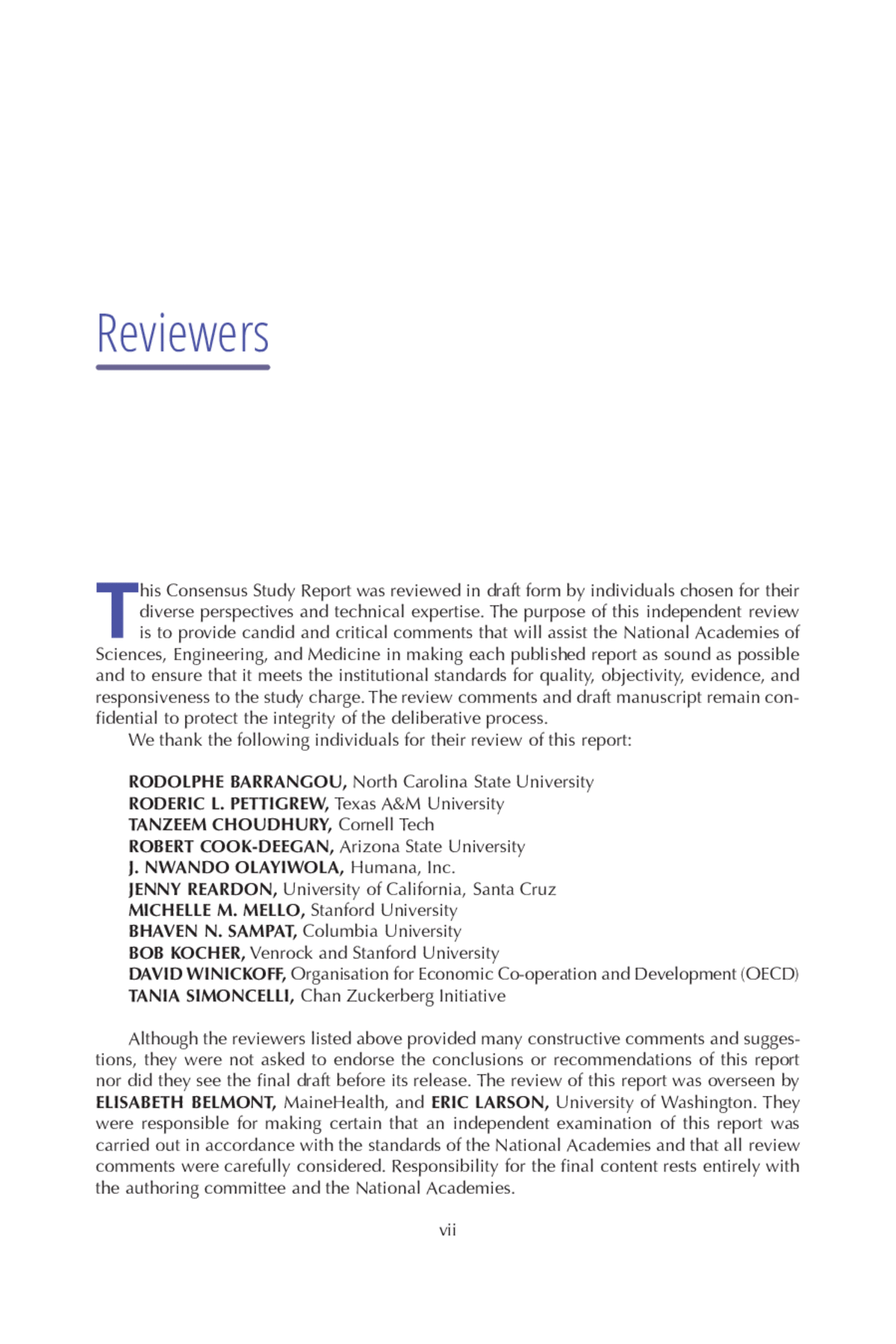Toward Equitable Innovation in Health and Medicine: A Framework (2023)
Chapter: Front Matter

Toward Equitable Innovation
in Health and Medicine
A Framework
_____
Committee on Creating a Framework
for Emerging Science, Technology, and
Innovation in Health and Medicine
Board on Health Sciences Policy
Health and Medicine Division
Consensus Study Report

NATIONAL ACADEMIES PRESS 500 Fifth Street, NW Washington, DC 20001
This activity was supported by grants between the National Academy of Sciences and the Gordon and Betty Moore Foundation through grant #8938.01, the Greenwall Foundation, the Public Interest Technology Infrastructure Fund through subgrant #01705-2022-09-01, the Robert Wood Johnson Foundation through grant #79541, Schmidt Futures, and Qualcomm Inc. Any opinions, findings, conclusions, or recommendations expressed in this publication do not necessarily reflect the views of any organization or agency that provided support for the project.
International Standard Book Number-13: 978-0-309-70761-9
International Standard Book Number-10: 0-309-70761-7
Digital Object Identifier: https://doi.org/10.17226/27184
This publication is available from the National Academies Press, 500 Fifth Street, NW, Keck 360, Washington, DC 20001; (800) 624-6242 or (202) 334-3313; http://www.nap.edu.
Copyright 2023 by the National Academy of Sciences. National Academies of Sciences, Engineering, and Medicine and National Academies Press and the graphical logos for each are all trademarks of the National Academy of Sciences. All rights reserved.
Printed in the United States of America.
Suggested citation: National Academies of Sciences, Engineering, and Medicine and National Academy of Medicine. 2023. Toward equitable innovation in health and medicine: A framework. Washington, DC: The National Academies Press. https://doi.org/10.17226/27184.
The National Academy of Sciences was established in 1863 by an Act of Congress, signed by President Lincoln, as a private, nongovernmental institution to advise the nation on issues related to science and technology. Members are elected by their peers for outstanding contributions to research. Dr. Marcia McNutt is president.
The National Academy of Engineering was established in 1964 under the charter of the National Academy of Sciences to bring the practices of engineering to advising the nation. Members are elected by their peers for extraordinary contributions to engineering. Dr. John L. Anderson is president.
The National Academy of Medicine (formerly the Institute of Medicine) was established in 1970 under the charter of the National Academy of Sciences to advise the nation on medical and health issues. Members are elected by their peers for distinguished contributions to medicine and health. Dr. Victor J. Dzau is president.
The three Academies work together as the National Academies of Sciences, Engineering, and Medicine to provide independent, objective analysis and advice to the nation and conduct other activities to solve complex problems and inform public policy decisions. The National Academies also encourage education and research, recognize outstanding contributions to knowledge, and increase public understanding in matters of science, engineering, and medicine.
Learn more about the National Academies of Sciences, Engineering, and Medicine at www.nationalacademies.org.
Consensus Study Reports published by the National Academies of Sciences, Engineering, and Medicine document the evidence-based consensus on the study’s statement of task by an authoring committee of experts. Reports typically include findings, conclusions, and recommendations based on information gathered by the committee and the committee’s deliberations. Each report has been subjected to a rigorous and independent peer-review process and it represents the position of the National Academies on the statement of task.
Proceedings published by the National Academies of Sciences, Engineering, and Medicine chronicle the presentations and discussions at a workshop, symposium, or other event convened by the National Academies. The statements and opinions contained in proceedings are those of the participants and are not endorsed by other participants, the planning committee, or the National Academies.
Rapid Expert Consultations published by the National Academies of Sciences, Engineering, and Medicine are authored by subject-matter experts on narrowly focused topics that can be supported by a body of evidence. The discussions contained in rapid expert consultations are considered those of the authors and do not contain policy recommendations. Rapid expert consultations are reviewed by the institution before release.
For information about other products and activities of the National Academies, please visit www.nationalacademies.org/about/whatwedo.
COMMITTEE ON CREATING A FRAMEWORK FOR EMERGING SCIENCE, TECHNOLOGY, AND INNOVATION IN HEALTH AND MEDICINE1
KEITH WAILOO (Co-Chair), Henry Putnam University Professor of History and Public Affairs, Princeton University, New Jersey
KEITH YAMAMOTO (Co-Chair), Vice Chancellor for Science Policy and Strategy; Director, UCSF Precision Medicine; Professor Emeritus, Cellular and Molecular Pharmacology, University of California, San Francisco
AMY ABERNETHY, President, Product Development and Chief Medical Officer, Verily, San Francisco, California
DAVID ASCH, Senior Vice Dean for Strategic Initiatives at the Perelman School of Medicine and the John Morgan Professor at the Perelman School and the Wharton School at the University of Pennsylvania
OLVEEN CARRASQUILLO, Professor of Medicine and Public Health Sciences, University of Miami, Florida
AMITABH CHANDRA, Ethel Zimmerman Wiener Professor of Public Policy and Henry and Allison McCance Professor of Business Administration, Harvard University, Massachusetts
R. ALTA CHARO, Principal, Alta Charo Consulting LLC and Warren P. Knowles Professor Emerita of Law & Bioethics, University of Wisconsin–Madison
HANA EL-SAMAD, Senior Vice President and Director of Science Integration, Innovation and Insights and Founding Principal Investigator, Altos Labs, California
MICHELE BRATCHER GOODWIN, Linda D. & Timothy J. O’Neill Professor of Constitutional Law and Global Health Policy, Georgetown Law School, Washington, DC
ANTHONY RYAN HATCH, Professor of Science in Society, African American Studies, Environmental Studies, and Sociology, Wesleyan University, Connecticut
JIANYING HU, IBM Fellow, Director of HCLS Research, and Global Science Leader, AI for Healthcare, IBM Research, New York
LISA I. IEZZONI, Professor of Medicine, Harvard Medical School, Massachusetts
ALEX JOHN LONDON, Clara L. West Professor of Ethics and Philosophy, Carnegie Mellon University, Pennsylvania
DEBRA MATHEWS, Associate Director for Research and Programs, Berman Institute of Bioethics and Associate Professor of Genetic Medicine, Johns Hopkins University, Maryland
SHOBITA PARTHASARATHY, Professor of Public Policy and Professor of Women’s and Gender Studies, University of Michigan
TIMOTHY M. PERSONS, Partner, PricewaterhouseCoopers LLP, Washington, DC
ARTI RAI, Elvin R. Latty Professor of Law, Duke University, North Carolina
KAUSHIK SUNDER RAJAN, Professor of Anthropology and Social Sciences, The University of Chicago, Illinois
KRYSTAL TSOSIE, Assistant Professor, Arizona State University and Co-founder, Native BioData Consortium, Arizona
___________________
1 NOTE: See Appendix E, Disclosure of Unavoidable Conflicts of Interest.
NAM Fellows
ANDREW A. GONZALEZ, Gilbert S. Omenn Fellow and Assistant Professor of Surgery, Indiana University
STEVEN LIN, James C. Puffer, American Board of Family Medicine Fellow and Clinical Associate Professor, Stanford University, California
Study Staff
KATHERINE BOWMAN, Study Director, Board on Health Sciences Policy
ANDREW BREMER, Program Officer, Board on Life Science
MELISSA LAITNER, Special Assistant to the President, National Academy of Medicine
CELYNNE BALATBAT, Associate Program Officer, National Academy of Medicine
MICHAEL BERRIOS, Research Associate, Board on Health Sciences Policy
VICTORIA CHEGE, Senior Program Assistant, Board on Health Sciences Policy
CHRISTIE BELL, Finance Business Partner, Board on Health Sciences Policy
CLARE STROUD, Senior Director, Board on Health Sciences Policy
KIMBER BOGARD, Deputy Executive Officer, Programs, National Academy of Medicine
Consultants
RONA BRIERE, Senior Editor, Briere Associates, Inc.
LEE A. BLEVINS ZAJAC, Editorial Assistant, Briere Associates, Inc.
ALLIE BOMAN, Editorial Assistant, Briere Associates, Inc.
JOHN HAWKINS, Editorial Assistant, Briere Associates, Inc.
ANNE JOHNSON, Founder and Lead Science Writer, Creative Science Writing, LLC
PEAK SEN CHUA, Consultant, National Academy of Medicine
Reviewers
This Consensus Study Report was reviewed in draft form by individuals chosen for their diverse perspectives and technical expertise. The purpose of this independent review is to provide candid and critical comments that will assist the National Academies of Sciences, Engineering, and Medicine in making each published report as sound as possible and to ensure that it meets the institutional standards for quality, objectivity, evidence, and responsiveness to the study charge. The review comments and draft manuscript remain confidential to protect the integrity of the deliberative process.
We thank the following individuals for their review of this report:
RODOLPHE BARRANGOU, North Carolina State University
RODERIC L. PETTIGREW, Texas A&M University
TANZEEM CHOUDHURY, Cornell Tech
ROBERT COOK-DEEGAN, Arizona State University
J. NWANDO OLAYIWOLA, Humana, Inc.
JENNY REARDON, University of California, Santa Cruz
MICHELLE M. MELLO, Stanford University
BHAVEN N. SAMPAT, Columbia University
BOB KOCHER, Venrock and Stanford University
DAVID WINICKOFF, Organisation for Economic Co-operation and Development (OECD)
TANIA SIMONCELLI, Chan Zuckerberg Initiative
Although the reviewers listed above provided many constructive comments and suggestions, they were not asked to endorse the conclusions or recommendations of this report nor did they see the final draft before its release. The review of this report was overseen by ELISABETH BELMONT, MaineHealth, and ERIC LARSON, University of Washington. They were responsible for making certain that an independent examination of this report was carried out in accordance with the standards of the National Academies and that all review comments were carefully considered. Responsibility for the final content rests entirely with the authoring committee and the National Academies.
This page intentionally left blank.
Acknowledgments
The committee would like to express its sincere gratitude to the speakers, panelists, respondents to the call for input, and others who shared their views with the committee, as well as to Alexis Walker and Michael McGovern for authoring commissioned papers presented in Appendixes of this report.
The committee is also grateful for the contributions of Rona Briere, senior editor, Allie Boman, Lee A. Blevins Zajac, and John Hawkins, editorial assistants, Anne Johnson, science writer, and Peek Sen Chua, consultant, along with Christopher Lao-Scott, senior librarian of the National Academies Research Center, for his crucial assistance with fact checking.
This page intentionally left blank.
Contents
Past and Current Efforts Toward Advancing Equity
National Academy of Medicine’s Emphasis on Emerging Science, Technology, and Innovation
Beyond Research Ethics: Enhanced Attention to Equity, Justice, and Fairness
2 TAKING EQUITY SERIOUSLY IN INNOVATION
Justification for Considering Equity in the Medical Technology System
Definition of Equity: What Equity is, and What It Is Not
Case Study: Equity in Relation to Disability
Applying Equity Principles in Technology Development and Innovation
3 THE INNOVATION LIFE CYCLE IN HEALTH AND MEDICINE AND THE CHALLENGE OF EQUITY
Conceptual Overview of the Innovation Life Cycle
Assessment of the Existing Innovation System
Failure to Address Equity Holistically in the Current System
4 A GOVERNANCE FRAMEWORK FOR ALIGNING INNOVATION IN HEALTH AND MEDICINE WITH EQUITY
Five Imperatives That Guide the Framework
Illustrating How the Framework Can Influence the Innovation Ecosystem
Leverage Points Influencing the System to Implement the Framework
5 REIMAGINING THE INNOVATION LIFE CYCLE: CONCRETE STEPS TOWARD EQUITY
Introduction to the Recommendations
Galvanizing National Leadership and Setting Priorities
Enhancing the Culture of Ethical Innovation
Making Targeted Use of Governance Incentives
Expanding Who Participates in Innovation
Creating Context-Specific Playbooks
An Action Agenda for Stakeholders in the Innovation System
A Information Sources and Methods
B Technology Governance and Equity in US History (McGovern and Wailoo)
C Equity in Innovation within NIH and FTC (Walker)
Boxes, Figures, and Tables
BOXES
1-3 Selected Themes and Comments from a Public Survey
2-1 The Pulse Oximeter: An Example of Inequity in Health Technology
3-1 From Basic Science to Big Business
3-2 Public Funding, Equity, and Treatment for Hepatitis C
3-3 Case Study of Artificial Intelligence/Machine Learning (AI/ML) Technologies in Health Innovation
4-1 Community and Academic Engagement in Flint, Michigan
4-2 Examples of Initiatives Emphasizing Community Participation and Benefit Sharing
4-3 Patent-Level Levers Used in Other Countries
4-4 Equity Considerations in the Production of Artemisinin
4-6 Development of Drug Therapies for HIV/AIDS
4-7 The Open Insulin Foundation
4-9 Equity Considerations during the Postmarket Phase: Makena
4-10 Unlocking Nursing Knowledge to Develop Front-line Medical Innovations
FIGURES
2-1 Scenarios conceptualizing equity as something more or other than equality
3-1 A simplified conceptual model of the innovation life cycle
3-2 Varying levels of community engagement
TABLES
S-1 Summary of Recommendations
S-2 An Action Agenda for Stakeholders
2-1 Dimensions of Equity Relevant to Innovation













